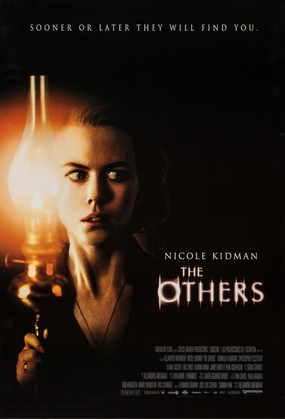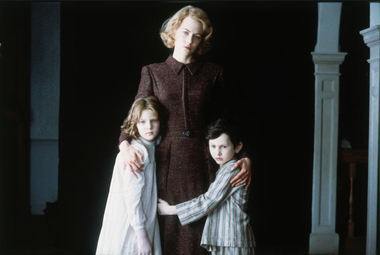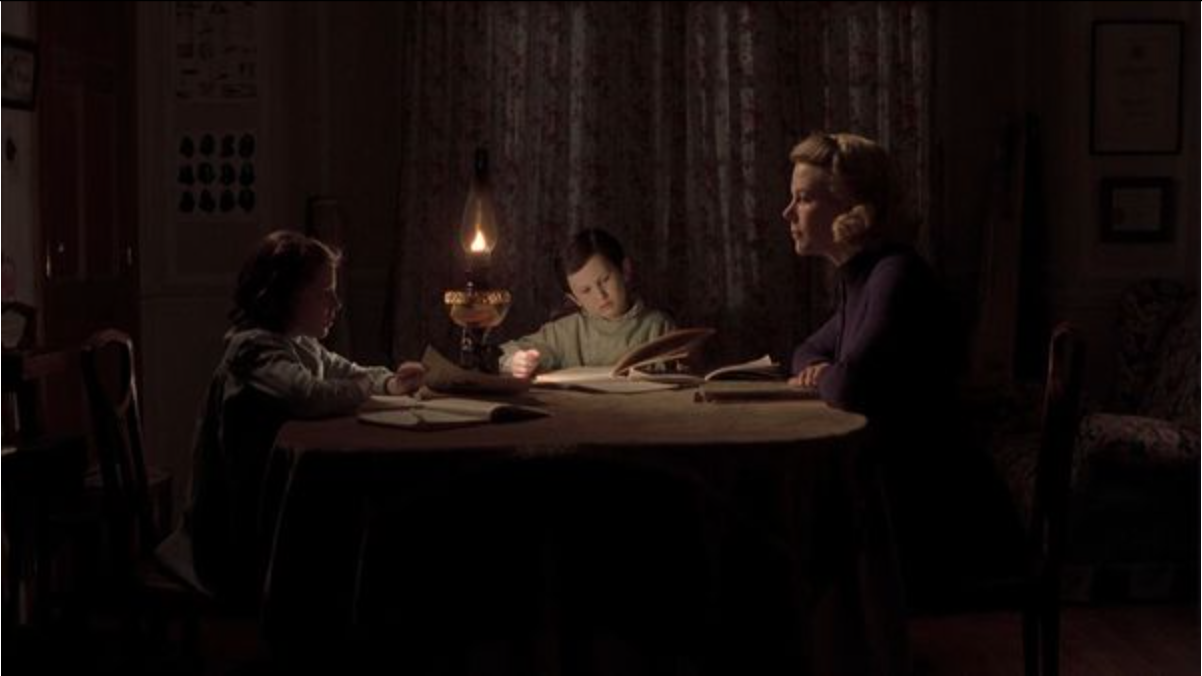 Warning: there are spoilers in this post! This film, released in 2001, was written, directed, and scored by Alejandro Amenábar and stars Nicole Kidman. The movie was a box office success and critically acclaimed both due to Kidman’s performance and Amenábar’s clever script. I posit that this script is a perfect example of asking all the right “what if” questions in order to arrive at a unique story with a killer surprise ending. When we sit down to write a story we are asking ourselves many “what if” questions as we contemplate every aspect from characterization to plot. I can only presume that Amenábar set out to write a Gothic Horror script that subverted expectations and played with typical notions of time and space. In this essay, I’ll imagine how Amenábar worked through these questions. Perhaps he began with the genre convention of a spooky mansion but asked himself, “what could make this house more spooky?” Perhaps it is half empty and half filled with the previous owner’s belongings, covered with sheets. Maybe it is dark all of the time inside, to make it extra spooky. Then comes the question, “why would it be dark inside all of the time?” Amenabar decides that the story is set just after World War II. The family is so accustomed to living without electricity due to all of the outages during the war that they never bother to have electricity installed. That would make the house much darker inside—especially at night. The inhabitants would be forced to rely on candle and lamp light. That means small pools of flickering light and deep shadows—a perfect setting for one’s mind to play tricks. Perhaps he thought, “This is good, but it would be even better if it were also dark during the daytime. What reason could there be for darkness inside the house during the day?” Perhaps he had heard of the rare disease Xeroderma pigmentosum. One would have to assume that with only 1000 modern cases in the world, there would be people afflicted with the condition in the 1940s, but it would not be well understood. This genetic disease causes an intense and dangerous reaction to sunlight. Most afflicted children do not make it to adulthood because limiting sun exposure is so difficult. This not only fulfills his need to make the enormous mansion dark and spooky even during the day but it also adds an element of high stakes—the children must be protected from light and even the smallest misstep could have dire consequences. Things must be muddled. Let’s make the mother a strict disciplinarian who is clearly off-balance—make the audience wonder if she is on the verge of a nervous breakdown or another form of mental illness. And add three other characters in the form of servants, who sometimes appear to be generous and kind and other times seem to be acting very suspicious. Make the mother desperate for help, such that she takes them on without references. Also, throw in a husband, thought to have died in the war, who is shell-shocked from trench warfare.  Now, Amenábar may have thought, how can I subvert my audience’s expectations? A surprise twist at the end. Yes. Perfect. We always read and watch ghost stories from the human point of view. Is there a way we can turn this on its head? Ah, yes. Write the story from the ghost’s point of view. Can we make that even stranger somehow? The mother is unhinged... perhaps she doesn’t know she’s dead. Perfect. What other elements could be added to make things extra creepy? The little girl could see things that the adults can’t. Throw in a photo album full of death portraits, mysterious fog, unseen children crying and playing, doors that shut on their own, and pianos that play themselves. Anything else? Make the mother so neurotic she not only closes every door, she locks them. Perhaps one more genre convention to round things out. A seance led by a spiritualist. Yes, that plays into the twist at the end perfectly. I hope Alejandro Amenábar will forgive me for supposing I can imagine his thought processes, but I found this plot and characterization so fascinating, so refreshingly new, that I had to think about how he may have come up with it. Thinking this way—in particular: how do I subvert the reader/watcher’s expectations and surprise them—can really make for a fresh take on a common story. Readers want to read stories that feel comfortable and familiar while also surprising them. It behooves us as writers to imagine what elements of common genre conventions we wish to use on their face and which ones we want to contort into something new. In this case, the dark, lonely mansion and the mentally ill woman living in the house are genre conventions. But most of the rest of this story feels entirely new. I think that is the secret to this movie’s success. Kidman’s incredible performance didn’t hurt either. Postscript: Unfortunately, at the time of this writing, The Others is not available on any US streaming service. I believe this may have something to do with a television adaptation in development.
4 Comments
3/14/2022 09:23:07 am
Amenábar did a great job of subverting expectations. Was this your first time watching this film? If so, I'm interested to know your reaction--what went through your mind--at the seance in the climax and "reality" becomes clear.
Reply
3/19/2022 04:32:50 pm
Yes, this was my first time seeing this film. I wasn't even aware of its existence.
Reply
The death photos were a great detail. Interesting to me how honoring someone's passing has changed. Death photos used to be common, along with mourning jewelry with a lock of hair or other memento. These days, death photos are considered to be tabloid fodder.
Reply
Michelle
3/19/2022 05:19:14 pm
Jen-
Reply
Leave a Reply. |
Jennifer Foehner WellsI'm an author of the space-opera variety. Archives
April 2022
Categories |


